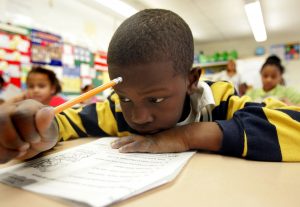 On Tuesday, the US Department of Education released a collection of data tracking roughly 50 million students from almost every single one of the country’s 95,000-some public schools. This is the most recent installment of the Civil Rights Data Collection survey, which examines data from the 2013-2014 school year.
On Tuesday, the US Department of Education released a collection of data tracking roughly 50 million students from almost every single one of the country’s 95,000-some public schools. This is the most recent installment of the Civil Rights Data Collection survey, which examines data from the 2013-2014 school year.
While this survey is an annual look at the state of affairs in public education in America, this year’s data is, perhaps, more shocking than those of the past. According to the data, white students make up more than half of all enrollment; Latino students make up about one-quarter while black students make up roughly 15 percent of the population. Although the male to female ratio was more even (51.4 percent to 48.6 percent) students with disabilities occupied about 14 percent of the space and English learning students just shy of 10 percent.
In response to the data trove, US Secretary of Education John B. King, Jr, says, “Our systemic failure to educate some groups of children as well as others tears at the moral fabric of the nation.”
King also notes that while some gains have been made, Latino and black students continue to be more likely to be issued suspensions and are more likely to attend schools with inexperienced teachers. Also, he says, these students have consistently less access to accelerated and advanced classes (such as Algebra II, chemistry, calculus, and physics)
Indeed, suspensions have dropped 20 percent (though still totals 2.8 million), but black students are four times more likely to be suspended and twice as likely to be expelled, than white students.
King continues, “Fewer suspensions is an important sign of progress, But I don’t think there’s any way you can look at this data and not come away with a tremendous sense of urgency about continuing to close our equity gaps.”
In addition, black students also appear to be twice as likely to be referred to law enforcement or arrested during school hours
